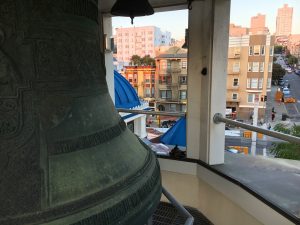The ringing of the bells serves two functions in the Orthodox Church. The first is for calling the faithful to divine services, and the second is to announce the beginning of various parts of the services to those faithful who are absent from the church.
The different manners or ways of ringing
1) Blagovest – literally “Good News.” This is the measured striking of one bell for the beginning of a service.
2) Zvon – literally “Peal.” This is the ringing of all bells.
3) Dvuzvon – literally “Double Peal.” This is the ringing of all bells then an interval of silence, followed by a second ringing of all bells. Simply put, this is the ringing of all bells twice.
4) Trezvon – literally “Treble Peal.” This is the ringing of all bells three times.
5) Perezvon – “Chain-peal.” This is the striking of each bell several times beginning with the largest bell and proceeding to the smallest bell. This chain is repeated as long as necessary. This is used before any Blessing of Water.
6) Perebor – “Chain-toll.” The slow striking of each bell once beginning from the largest bell and proceeding to the smallest bell. After the chain, all bells are rung together. This is repeated several times. This is also called burial or funeral ringing.
 Bell Ringing at All-Night Vigil
Bell Ringing at All-Night Vigil
The blagovest is rung before the service and is immediately followed by the trezvon. At the beginning of the reading of the Hexapsalmion or before it the dvuzvon takes place. Immediately before the reading of the Gospel, the zvon takes place. During the Magnificat the bell is struck nine times. At the conculsion of the Vigil, the trezvon is rung.
Bell Ringing at the Divine Liturgy
The blagovest is rung at the appointed time and ceases at the beginning of the Hours. At the endof the 6th hour the trezvon is rung. At the end of the Creed, which consists of 12 parts, the bell is struck 12 times in a unhurried fashion to inform those Christians who are absent that the time of the Consecration of the Holy Gifts approaches. After the Liturgy the trezvon is rung.
At Lenten and Royal Hours
Before the Hours during Great Lent and at Royal Hours, the number of times the bell is struck corresponds to which Hour is being read. At the Third Hour, the bell is struck three times, at the 6th, six times, and at the 9th, nine times.
Vespers of Holy Friday
At the bringing out of the Plaschanitsa and before the procession around the church the perebor is rung and immediately thereafter the trezvon.
Bell Ringing at Funerals
The perebor is used at the carrying out of the deceased from the temple for burial. There is no trezvon after this bell.
Bell Ringing at Moliebens with the Blessing of Water
When the cross is immersed into the water, a short trezvon takes place.
Bell Ringing at the Hierarchical Divine Liturgy
The blagovest is sounded at appointed time. As the Hierarch approaches the temple, all the bells are rung. When the Hierarch enters the temple, the ringing stops and the blagovest is resumed until the beginning of the vesting of the Hierarch. At the beginning of the Sixth hour the trezvon is sounded unless there is an ordination to the rank of reader or to the subdiaconate, in which case the trezvon is sounded after the Bishop’s prayers before the Divine Liturgy.
-From Archpriest Rostislav Gan’s explanations of the Divine services.
Translated and edited from the Russian by Rev. Victor Sokolov and Kirill Sokolov